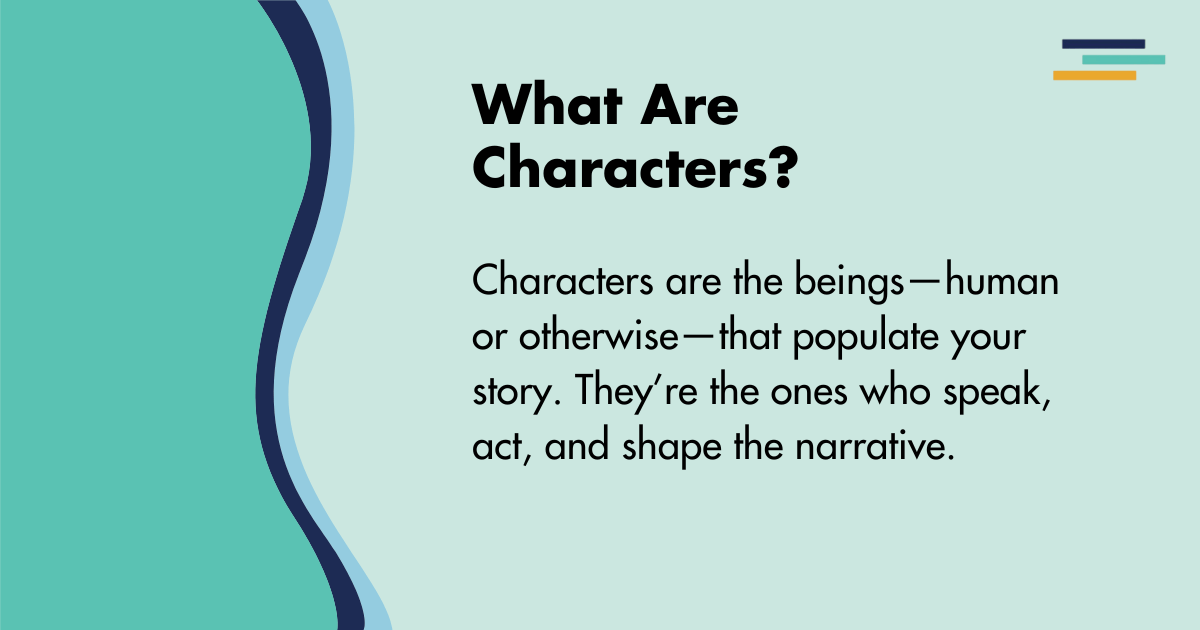
In any story, characters are the lifeblood that make readers care, laugh, cry, or sometimes throw the book across the room.
No?
Just me.
Okay then.
Whether they’re leading the charge or quietly supporting the plot from behind the scenes, characters drive the emotional core of a story. But not all characters are created equal. Some develop, others keep the plot moving forward.
The key to writing memorable stories often lies in understanding and mastering the different character archetypes in literature.
In this article, we’ll explore the various character types that appear in stories, how to spot them, and provide tips for writing dynamic characters that engage readers.
What Are Characters in a Story?
Before we dive into the specifics, let’s cover the basics.
What exactly are characters?
Characters are the beings—human or otherwise—that populate your story. They’re the ones who speak, act, and shape the narrative. But characters are more than just tools for moving the plot along. They’re the heart and soul of a story, serving as stand-ins for real people, complete with:
- Desires
- Flaws
- Strengths, and
- Complex emotions.

Characters allow readers to experience the story firsthand, creating a connection that draws them deeper into the narrative.
Whether it’s a noble hero, a misunderstood villain, or the quirky best friend, characters are the bridge between the reader and the fictional world. Without them, you’d have a beautifully crafted plot…
But no one to experience it.
Types of Characters in a Story
Characters come in all shapes, sizes, and personalities.
Knowing the various character archetypes is essential to understanding how they interact with the plot and with each other.
Below is a breakdown of the most common character types, along with examples to illustrate each one.
Protagonist
The protagonist is the character at the center of the story.
They’re the one the audience roots for (most of the time), and they often drive the central conflict forward. Whether they’re the classic hero or someone more morally complex, the protagonist’s journey is the focus of the plot.
Example:
Katniss Everdeen in The Hunger Games is a perfect example of a protagonist.
Her struggle to survive in the deadly arena, combined with her moral complexity and growing sense of responsibility, makes her an interesting lead character. She’s not perfect—far from it—but that’s what makes her relatable.
Protagonists are often deeply flawed, which only enhances their journey. Imagine how dull Frodo would be if he were invulnerable to the power of the One Ring.
Antagonist
The antagonist is the character who opposes the protagonist.
They create conflict, stand in the protagonist’s way of their goals, and often serve as the story’s primary source of tension. But antagonists don’t always have to be evil. In fact, some of the most interesting antagonists are those who believe they’re the hero of their own story.
Example:
In Harry Potter, Voldemort is the quintessential antagonist.
His constant pursuit of power and desire to rid the world of non-pureblood wizards makes him a formidable foe. He’s a villain through and through, but one with a backstory and motivations that, while twisted, are rooted in his fear of death.
However, not all antagonists are dark lords.
Take Javert in Les Misérables, whose unwavering dedication to the law puts him in direct conflict with Jean Valjean. Javert isn’t evil. He’s just misguided.
Mentor
The mentor archetype is a wise figure who helps guide the protagonist on their journey.
Often older and more experienced, the mentor offers knowledge, advice, and sometimes magical tools or skills to help the protagonist overcome challenges.
The mentor’s role is crucial in preparing the protagonist for their journey, but they rarely stick around for the entire story. Sometimes this is because they’ve done their job, or in more dramatic cases, they meet an untimely demise, leaving the protagonist to face their ultimate challenge on their own.
Example:
In The Lord of the Rings, Gandalf serves as a mentor to Frodo.
While he offers guidance and wisdom, he also trusts Frodo to make critical decisions on his own. Gandalf’s wisdom and foresight help set Frodo on the right path, but ultimately, it’s Frodo who must carry the burden of the One Ring.
Mentors add depth to the story by challenging the protagonist to grow and by reminding the reader that every hero needs help along the way.
Dynamic Characters
Dynamic characters are those who undergo significant internal changes over the course of the story.
This transformation might be emotional, psychological, or moral, and it’s often at the heart of a story’s theme. Dynamic characters experience growth, sometimes painfully so, which keeps them interesting and relatable.
Example:
In A Christmas Carol, Ebenezer Scrooge is the ultimate dynamic character.
He starts off as a miserly, cold-hearted man, but by the end, transforms into someone warm, generous, and kind. Scrooge’s internal journey is a perfect example of how a character can develop in response to the events of the plot.
This character arc is essential in most stories because without change, readers might struggle to stay invested in a character’s journey.

Static Characters
Unlike dynamic characters, static characters remain unchanged throughout the story.
Their personality, values, and outlook remain constant from beginning to end. Static characters can serve as anchors for the protagonist, or they might provide a sense of stability in a story full of chaos.
Example:
People often consider Sherlock Holmes as a static character.
No matter how many cases he solves, he remains the brilliant but emotionally detached detective. His intellect and sharp wit remain consistent, and while the surrounding mysteries may change, Sherlock himself stays much the same.
Static characters often play supporting roles in stories, offering a sense of consistency and reliability that helps ground the plot.
Round Characters
Round characters are fully fleshed-out individuals with a complex mix of traits, motivations, and emotions. These characters feel like real people because they’re multifaceted.
Readers can relate to their internal conflicts, their moral dilemmas, and their very human flaws.
Example:
Elizabeth Bennet from Pride and Prejudice is a classic round character.
She’s witty, intelligent, and principled, but she’s also quick to judge and can be stubborn. Her complexity makes her an interesting character who feels real, and her growth over the course of the novel only adds to her depth.
Round characters are essential in literary fiction, where character-driven plots rely on fully developed individuals to explore complex themes.
Flat Characters
Flat characters are one-dimensional. They usually embody a single trait or idea and serve a specific function within the story.
While they lack the complexity of round characters, flat characters can still be effective in advancing the plot or highlighting the protagonist’s traits.
Example:
Mr. Collins in Pride and Prejudice is a flat character.
His obsequiousness and social awkwardness are his defining traits, and while he adds comic relief and serves as a foil to Elizabeth’s intelligence, he doesn’t experience significant growth or complexity.
Flat characters can be especially useful in supporting roles, providing contrast to the protagonist or injecting humor with no deep backstory.
Foil Characters
A foil character exists to highlight the traits of another character, often the protagonist.
By contrasting with the main character, the foil brings out certain qualities that might otherwise go unnoticed. Foils don’t always have to be antagonists, though. They can simply be a counterpoint to the protagonist’s personality.
Example:
In Harry Potter, Draco Malfoy serves as a foil to Harry.
While Harry is brave and selfless, Draco is cowardly and self-serving. This contrast helps underscore Harry’s moral compass and his capacity for forgiveness, even toward someone like Draco.
Foil characters are a great tool for adding depth to your protagonist by showing them through a different lens.
Stock Characters
Stock characters are instantly recognizable because they’re based on common stereotypes or tropes.
Think of the wise old mentor, the mad scientist, or the star-crossed lovers. Stock characters fill a familiar role in the story and can be useful for quickly establishing certain dynamics.
Example:
In Star Wars, Obi-Wan Kenobi fits the “wise old mentor” archetype.
He’s there to guide Luke Skywalker on his journey, offering wisdom and support. While his role is familiar, people love Obi-Wan’s character for his calm demeanor and quiet strength.
Stock characters can be a valuable storytelling shortcut, but overusing them without adding nuance can lead to cliché. Balance is key.
Confidant
The confidant is a character in whom the protagonist confides, revealing their inner thoughts and struggles to the audience. While the confidant may not be the central character, they play a crucial role in helping the protagonist work through their challenges.
Example:
In Hamlet, Horatio serves as Hamlet’s confidant, offering advice and support as Hamlet grapples with his existential crisis. Through their conversations, the audience gains insight into Hamlet’s troubled mind.
The confidant helps to expose the protagonist’s vulnerabilities, making them a valuable character type for deepening emotional resonance.
How to Identify Character Types
Identifying character types in literature can be a fun and rewarding exercise. Here are some quick tips to help you classify characters in a story:
- What’s their role in the plot? If they’re driving the central conflict, they’re likely the protagonist or antagonist. Supporting roles belong to confidants, foils, or stock characters.
- Do they change? If the character undergoes significant personal growth, they’re dynamic. If they remain the same throughout, they’re static.
- Are they complex or simple? Round characters are well-developed and multi-dimensional, while a single trait or idea defines flat characters.
These questions will help you spot the character types in any story and understand how they contribute to the narrative.
Character Arcs and Why They Matter
A character arc is the internal transformation a character experiences throughout the course of a story.
It’s what turns a story from a sequence of events into an emotional journey.
While character types define the role a character plays, the arc defines how they change. Or, sometimes, how they stubbornly refuse to change. Understanding character arcs is crucial because, more often than not, it’s the character’s evolution that resonates with readers and leaves a lasting impression.
At the heart of most stories is a protagonist who is different at the end than they were at the beginning.
Let’s dive into the different character arcs, and why they’re so important.
Positive Arcs
A positive arc shows the character learning, growing, or becoming a better version of themselves. This is often the classic hero’s journey arc, where the protagonist faces challenges, overcomes them, and changes for the better.
Think about Katniss Everdeen from The Hunger Games. She starts out simply trying to survive, but by the end of the trilogy, she becomes a symbol of revolution, taking on a responsibility far greater than herself.
Katniss’s arc is not just about physical survival. It’s about her moral evolution and growing sense of duty.
Positive arcs are about growth, but they’re also about overcoming flaws.
A character might begin the story with a weakness or belief that holds them back, but through the challenges they face, they emerge as a stronger, more self-aware person.
Negative Arcs
Not all character arcs end on a high note.
A negative arc shows a character’s decline, often involving a fall from grace or losing an essential part of their humanity.
Walter White from Breaking Bad exemplifies the negative arc. He begins as a sympathetic character. Just a high school chemistry teacher trying to provide for his family. But as he descends into the drug world, he becomes ruthless and power-hungry, transforming into a villain by the show’s end.
His arc shows how power can corrupt, showing that not all transformations are positive.
Negative arcs are interesting because they often serve as cautionary tales. They explore the darker side of human nature, and through the character’s downfall, they show what can happen when personal flaws or external pressures take over.
Flat Arcs
A flat arc is when the character remains largely the same throughout the story, but the world around them changes.
These characters often act as forces of stability in an otherwise chaotic world.
Sherlock Holmes is a prime example of a flat arc character. He doesn’t experience much personal growth, he remains the same brilliant detective throughout his stories, but his actions bring about a change in the people and situations around him.
Flat arcs are useful when the story’s focus isn’t on the character’s internal journey, but on how they influence others.
These characters have strong, unshakable beliefs or qualities that remain consistent and act as a catalyst for change in others.

Tips for Writing Characters in a Story
Creating characters that leap off the page and into the hearts (or fears) of your readers takes practice. Here are some tips to help you along the way:
1. Give Your Characters Flaws
Nobody’s perfect, and that includes fictional characters. A protagonist who always does the right thing can be a little dull, so give them flaws. Maybe they’re impulsive or have a fear of commitment. Just give them something to make them feel human.
2. Write Realistic Dialogue
Nothing pulls readers out of a story faster than wooden dialogue. Make sure your characters speak like real people. Unless, of course, they’re a robot, in which case, a little stiffness is totally acceptable.
3. Let Characters Drive the Plot
If your plot feels like it’s moving along without the characters’ influence, you might have a problem. Characters should make decisions that affect the outcome of the story, rather than just reacting to things that happen around them.
4. Let Characters Make Mistakes
Flawed characters are more relatable, and readers connect with them because they, too, are imperfect. Let your characters make mistakes that lead to consequences, both big and small. Whether it’s a decision based on fear, pride, or misunderstanding, mistakes can drive the plot forward and lead to valuable character growth.
5. Create Strong Motivations
Every character needs a reason for their actions, whether it’s driven by love, revenge, ambition, or fear. Strong motivations make characters’ decisions feel logical and help readers understand why they act the way they do. The clearer the motivation, the more authentic your character will seem.
6. Build Backstory, Even if It’s Hidden
A well-developed backstory helps inform how a character behaves in the present. While you don’t need to reveal every detail of a character’s past, having that information as the writer will guide their decisions and personality. A character’s history shapes their worldviews, so take the time to understand their past.
7. Vary Character Relationships
Make sure your characters don’t exist in a vacuum. The way they interact with others reveals more about who they are. Some relationships might be tense and filled with conflict, while others might be warm and supportive. The variety in how characters relate to each other will add depth and keep readers engaged.
8. Balance Action with Reflection
What characters do and how they think both shape them. It’s important to show their internal reflections alongside their actions. What is a character feeling after a heated argument? How do they process their own failures or victories? Balancing internal monologue with external action will give readers a deeper understanding of the character’s inner world.
9. Use Minor Characters to Support Major Themes
Minor characters aren’t just there to fill space. They can reinforce the themes and messages of your story. A wise mentor might embody the theme of growth, while a trickster might represent the chaos in your narrative. Use these characters to mirror or challenge the protagonist’s journey in subtle ways.
10. Make Their Appearance Reflect Personality
While it’s easy to describe a character’s physical appearance, it’s more impactful when that appearance ties into their personality. For instance, a character who’s meticulous might always have perfectly pressed clothes, while a character who’s carefree might have a more relaxed, disheveled look. Let their outward appearance hint at their inner traits.
With a solid understanding of the character types in literature and a few tricks up your sleeve for writing your own, you’re well on your way to creating a cast of memorable, dynamic characters.
Whether you’re crafting a hero with a heart of gold or an antagonist who loves to stir up trouble, remember that characters are the soul of your story.
And finally, always remember that the story comes first. Focus on:
- Creating engaging characters
- Penning interesting plots
- Structuring solid settings
A tool like Fictionary helps you turn your draft into an interesting story readers love. So, with a strong narrative foundation, your writing can truly shine.


